The Apple iPhone Air battery is a major point of interest. A smartphone’s power source is its lifeblood. Users demand all-day power and fast charging. The iPhone Air is Apple’s thinnest and lightest phone. This design raises questions about its battery. Can a super-thin phone deliver great battery life? This article explores the iPhone Air’s battery capacity, charging technology, and real-world performance. It provides a complete overview for potential buyers.
iPhone Air Battery Capacity
The iPhone Air features a Li-Ion 3149 mAh battery. This is a significant detail. The thin design led many to fear a smaller capacity. Apple’s engineering team worked to prevent this. They moved components to make space for a larger battery. This includes the camera bump, or “plateau.”
Specialized Comparisons
The iPhone Air’s battery is smaller than other iPhone 17 models. In comparison, the iPhone 17 has a 3692 mAh battery. Meanwhile, the iPhone 17 Pro Max comes with a massive 5088 mAh capacity. However, the iPhone Air’s capacity is still impressive. It is on par with some older, thicker models. For instance, the iPhone 13 Pro had a 3095 mAh battery. The iPhone Air’s battery is a marvel of design. It proves that thinness does not have to mean a huge compromise.
Apple achieved this with new battery technology. The iPhone Air uses a silicon anode battery. This is a big step forward. Silicon anodes offer higher energy density. This means more power can be packed into a smaller space. Many Android companies have already used this tech. Now Apple is bringing it to the iPhone.
Pros and Cons
- Pros:
- Remarkable capacity for such a thin design.
- Improved energy density thanks to silicon anode technology.
- Good for all-day use.
- Can be extended with an optional MagSafe battery pack.
- Cons:
- Smaller capacity than other iPhone 17 models.
- May not satisfy power users.
- May require an accessory for heavy use.
What a Buyer Should Know
Do not get too caught up in the mAh number. Apple’s integrated hardware and software are key. The A19 Pro chipset is very power efficient. iOS 26 also has an “Adaptive Power Mode.” This feature learns your usage patterns. It then conserves power when needed. This combination often leads to better battery life than specs suggest.
The iPhone Air’s battery life is excellent. Apple rates it for up to 27 hours of video playback. This is on par with the iPhone 16 Pro. The iPhone 17 standard model gets 30 hours. So, you give up a few hours of life. For many users, this is a small trade-off for the thin design.
Charging and Power Management
The iPhone Air’s charging is fast and efficient. It supports multiple charging methods. Users have flexibility in how they power up. This is an important consideration for daily use.
Wired and Wireless Charging
Wired charging is a fast option. The iPhone Air supports PD2.0. With a 20W or higher power adapter, it charges quickly. You can get a 50% charge in just 30 minutes. This is perfect for a quick boost.
Wireless charging is also a key feature. The iPhone Air supports both MagSafe and Qi2 standards. It reaches speeds up to 20W. Note that other iPhone 17 models reach 25W. This is a small compromise for the thin design. However, the difference is minimal in daily use. A full charge still happens quickly.
Reverse Wired Charging
The iPhone Air has a special feature. It offers 4.5W reverse wired charging. This lets you charge other devices. You can use a USB-C cable to charge AirPods or an Apple Watch. This is a convenient feature for users with multiple devices. It adds to the phone’s versatility.
Pros and Cons
- Pros:
- Fast wired charging.
- Fast wireless charging.
- Convenient reverse wired charging.
- MagSafe compatibility offers great accessory options.
- Cons:
- Wireless charging is slower than other iPhone 17 models.
- Reverse charging is quite slow.
What a Buyer Should Know
Consider your charging habits. If you use a charger every night, the charging speed is less critical. If you need quick boosts, the fast wired charging is a great benefit. The lower wireless speed is a minor issue. It won’t affect most users. The reverse charging feature is a nice bonus. It’s a lifesaver for charging small accessories on the go.
Conclusion
The Apple iPhone Air battery is a testament to clever engineering. It proves that you can have a thin phone with great battery life. The 3149 mAh capacity is not the biggest, but it is highly efficient. The combination of the A19 Pro chip and iOS 26 ensures all-day use for most people.
The charging is also a positive. It provides fast wired and wireless options. The slower wireless speed is a minor trade-off. For those who need more power, the MagSafe battery pack is an excellent option. It offers a huge boost without adding much bulk.
Overall, the iPhone Air’s battery story is a success. It meets the demands of modern users. It is a fantastic choice for those who value a thin, light design. You do not have to compromise on battery performance. The iPhone Air provides a great balance of design and function.
FAQ
What is the battery capacity of the Apple iPhone Air?
The Apple iPhone Air has a 3149 mAh battery.
How fast does the iPhone Air charge?
It can charge to 50% in 30 minutes with a 20W or higher wired adapter. Wireless charging reaches 50% in 30 minutes with a 20W MagSafe or Qi2 charger.
Does the iPhone Air support reverse charging?
Yes, it supports 4.5W reverse wired charging. This allows you to charge accessories like AirPods.
How does the iPhone Air’s battery life compare to the iPhone 17?
The iPhone Air offers up to 27 hours of video playback. This is 3 hours less than the standard iPhone 17’s 30 hours.
Is a MagSafe battery pack available for the iPhone Air?
Yes, Apple offers a new MagSafe battery pack. It extends the iPhone Air’s video playback to up to 40 hours.



